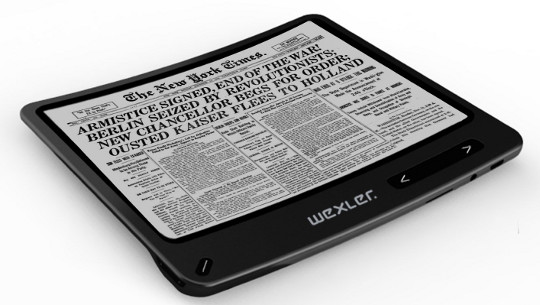Why is it that in 2017 we still don’t have a single option for a smaller ereader with a plastic-based screen?
E Ink has been making plastic screens for their 13.3-inch devices for a few years now, but why don’t they offer any smaller screens with a plastic substrate?
Normally you’d think of plastic as being a downgrade from glass, but when it comes to E Ink screens that is not the case.
Plastic-based screens are much more durable and lighter than glass screens.
A Kindle with a 6-inch plastic screen would be nearly unbreakable.
Current ereaders with glass screens are quite fragile. The glass isn’t very thick and can be easily broken, especially if put in a bag with other items.
E Ink screens are more prone to break than a typical screen on a tablet or phone, so why haven’t plastic screens remedied this problem?
Several years ago there was an ereader called the Wexler Flex One (pictured above) that had a plastic-based screen from LG, but it wasn’t on the market for very long and there were reports of problems producing the plastic screens. But if E Ink can successfully make 13.3-inch screens now why not 6-inch screens too?
E Ink screens have pretty much maxed out screen resolution at this point; anything more than 300 ppi on a 6-inch screen is just overkill that is going to hinder battery life and overall performance.
The next big improvement for E Ink screens should come in terms of durability and lighter weight. Plastic-based screens are the obvious answer. But will it ever happen?


The plastic screens I’ve encountered have been horrendous in their cheap feeling, being scratch-magnets and lack of clarity.
What’s needed is Gorilla Glass 4 or 5.
My very flush Voyage is very light and not fragile at all, thankyouverymuch. I’ve thrown it around for a couple of years now, mostly without a case – not the slightest scratch.
A better question is why we don’t have an affordable, quality, E Ink ereader that supports Google Play Store and Google Play Books without having to hack it for hours first!
Indeed. I wish Google was more serious about ebooks and had their own E Ink ereader too, but recent ebook sales reports indicate Google’s market share in the US is only like 2% at best. Considering the Play Books app comes preloaded on virtually every Android tablet and phone sold in the US that’s really sad.
Why Google or Apple hasn’t released a dedicated eReader considering they both have online bookstores practically means the juice aint worth the squeeze. And with Amazons boneheaded moves and lack of inspiration and disrespect for customers needs, I totally believe it.
Which makes me Kobo’s #1 fan for giving a damn. After just recently discovering their patches and possibilities I almost cried. Kindle is nonexistent to me after this epiphany.
What I’m saying is it doesn’t matter what Amazon does after this nor anybody else. Because with the Kobo Aura One, Bookerly, Constantina, Lyon and Brioni text fonts and patches, nothing else really matters. Amazon can kiss my arse! Goodbye for good! You lost!
Old Kobo eReaders, for example Kobo Glo, used to be plastic (and white), didn’t they?
Lots of ereaders have plastic casings but not plastic screens.
Situation with durable EPD screens looks like simple business protection by E-Ink company.
As soon as LG revealed its flexible screen used in Wexler reader, it was the first and the last EPD screen produced by this little company, one of the core business of which is a development of high tech screens. I’ll never believe that guys from LG which have succeeded in making physically flexible such complex screens like OLED and AMOLED
are stuck for 5 years since 2012 with 6 inch EPD. “Technical problems”….. come on guys, you still produce those old screens for Wexler. I’ve bought one for my niece two years ago on Aliexpress (still produced and sold) and it is alive up today jammed and kicked in kids schoolbag. Meanwhile, me myself have broken 3 high-end e-readers during this period.
To be honest, the fonts drawing of Wexler are not perfect and it has no lighting, however it is as contrast as Paperwhite from Amazon released years after.
If we forget about LG (as it looks preferable for all market players ;), E-Ink itself has this technology in hands but only for huge and expensive 13 inch displays…… WTF?
The answer, it is physically impossible to produce a big A4 size LIGHT tablet with thin glass and make it live in customer hands for more than a week, it should be more fragile than a fresh egg. Meanwhile, small screens are durable like boiled eggs, therefor live longer but it is “very important” for them to be mortal as they represent almost entire live market.
Summarizing all above, I wouldn’t expect any major changes in EPD screens market in nearest future as long as E-Ink holds global monopoly for screen production not without the help of their very strong US partner.